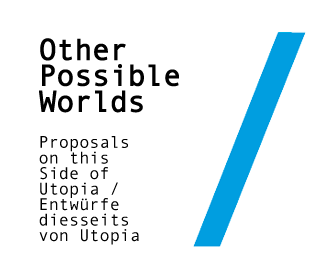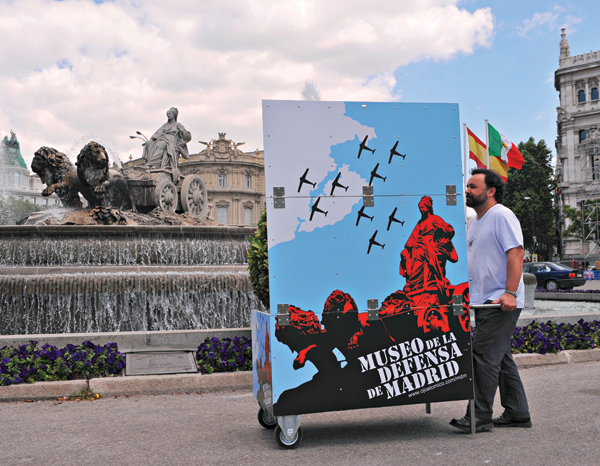antimuseoweb
Antimuseum
María María Acha, Tomás Ruiz-Rivas
Antimuseum’s proposal, as its name suggests, focuses on institutional critique. That is, we are interested especially in the “art institution” and its rules; in its internal and external dynamics; in its contradictions; and in the possibility of playing with them all. While conventional art criticism or curatorial work is interested in works of art as objects carrying meaning, and the artworld’s attention is directed to single figures with high visibility, for us the main question is to understand how the institution produces meaning and value. What interests us is not the statement of the artwork, but the conditions in which this statement is enunciated, and further, the structure of the enunciation. Our projects therefore seek to locate the limits of the institution in order to lead to situations where the legitimating structure of the art is revealed, to expose the exercise of power implicit in these processes, and with it, resulting forms of social and cultural exclusion.
But before entering into a description of Antimuseum’s more significant projects, we would like to make a clarification: usually it is inferred that an alternative space works “for” the artist; that is, it offers an alternative space of production and dissemination for the artist whose work exists outside the expositive framework of the gallery and the museum. The alternative space, in this sense, provides a context for the creator—both physical and discursive—in which to develop their work beyond the limits of the market and the museum. But we think that today the question is how to set up a space that can be alternative “for” the public. That is, a space that offers this complex social entity that we call the public, a physical, political and discursive context. It is space where we have access to the cultural experience, in a different way to the hegemonic one, and where the constitution of the public—as a social form—is based on antagonistic discourses.
When the ‚Atomic Eye‘ was founded in 1993, it fit to the first model and the creative needs of artists took precedence over other considerations. The context was particularly difficult, however, with the market crash of early nineties and an institutional paralysis that set in across Spain after the Olympics Games and Expo 1992. The Spanish artistic system has been dominated by the Art Fair ARCO in Madrid since it was established in 1982, since it has excluded everything that does not conform to the interests and the format of an art fair.
‚Atomic Eye’s‘ program focused on site-specific interventions in a large industrial building in which artists could experiment with languages and formats previously unrealized in Spain. The program has also a local and generational profile. The idea articulated within the project was that of the “shadow zone”—a social and cultural area that is semi-independent and semi-hidden from the local art system, and which could generate optimal working conditions. Although this concept caused difficulties with some artists—who sought above all to achieve visibility—my argument was precisely that achieving visibility within a distorted system necessarily affected work in a negative way. Since the construction of meaning is necessarily a social process, it was necessary to create a parallel subsystem that was perhaps interdependent, but that had its own rules.
It was during my stay in Mexico between 1997 and 2000—in the years before the international boom of Mexican art—that my attention began to shift from production towards the formation of the public. In 1998 I worked very closely with ‚La Panadería‘, and its influence was noticeable right away because it was a place where high and low culture, with their publics, are crossed in an amazing way. This year I worked on a big project — the exhibition Domestica, which involved nine flats in the Condesa neighborhood. Artworks invaded and changed particular homes, questioning limits between public and private, and showing the relation between the exhibition context and meaning production.
Consequently, when María María Acha and I reopened ‚Atomic Eye‘ in 2003, our assumptions were very different from the first stage. The project was still local however, because an alternative art space must be rooted firmly in its social and historical reality. At this level it responds to two specific issues: the centrality of ARCO in the Spanish art system, and the surge in contemporary art museums in Spain—with more than twenty five museums being built in five years since the successful Guggenheim franchise was established here. At this point we chose the name “Antimuseo” as an opposition to this type of institution in which the container is the main element and the programs or collections are devoid of meaning. Returning to our premise, at this stage the Antimuseo exhibition program was international, and the issues we were working with were therefore inserted into a large framework of critical thought about the museum institution, the crisis of the public sphere, the loss of autonomy within creative work, and the new role of culture in a post-Fordist economy. In this scenario—where the public sphere is more an arena for advertising than a place in which to stage rational and critical debate—as Craig Calhoun argues, the museum institution that was once so important in defining a new political bourgeois subject, faces an irreversible degradation and is assimilated into the entertainment industry. The public’s creative energy and ability to conduct rational and critical debate is led towards sophisticated forms of consumption, and it therefore loses what had been specific to its culture throughout the modern age: antagonism.
Antimuseo’s experience in recent years has been fruitful in this sense. There are several projects that exemplify particularly well the theories we are exposing. The first was ‚How do you imagine your plaza?‘, in which we collaborated with neighborhood associations and networks of the Prosperidad—the district in which Antimuseum was based—mobilizing the preservation the Prosperidad square as a social space. With the Museum of the Defense of Madrid, which was presented as an artwork by Tom Lavin, a deliberate ambiguity around the roles of curator and artist was implemented within a portable museum that, in some contexts, acted as a real museum and provoked conflicts about historical memory, and in other contexts, operated as a sculpture-performance, inducing its audience to think about the museum institution.
In ‚Sleeping Beauties‘, a work in progress that was launched in 2006, María María drives a process of collective creation that examines male violence against women. A simple sticker designed by the artist was the only tool in this process that involved more than 400 people and gathered a collection of more than 1000 photographs.
Finally, in Mexico between 2008 and 2009, we initiated the project ‚Portable Contemporary Art Center (PCAC)‘, which was financed by the AECID (Agencia Española de Cooperación International para el Desarrollo). The PCAC is a low cost device for art exhibitions and brief interventions, and can be moved and set up by one person. Its functions are both to support cultural activities—performances, lectures, and shows, for example—and also to mark the urban space. The PCAC creates a connection between the strategies of re-appropriation of the city by marginalized groups—racial minorities, street vendors, prostitutes, immigrants, homosexuals in repressive contexts, and some female groups—and artistic practices that directly affect the urban tissue.
The PCAC is not an artwork. It is a museum, and it therefore does not project itself from conflict areas into the regulated spaces of the artworld, as normally happens with similar projects undertaken by artists. Its place is the street and it is directly inserted as an accomplice within the struggles for appropriation and resignification that take place throughout public space.
In 2009, an intervention program was conducted in peripheral areas of Mexico City with collaboration from groups of artists and activists. Faced with regressive experiences in which collaboration with communities is often enfolded by a hierarchical perspective, the groups involved here did not operate as the object of the project—reified for consumption in circuits of high culture—but they took a central place precisely as a public, or more precisely as a counter-public. A new social space was produced; an opposite of that shaped by hegemonic cultural practices.



